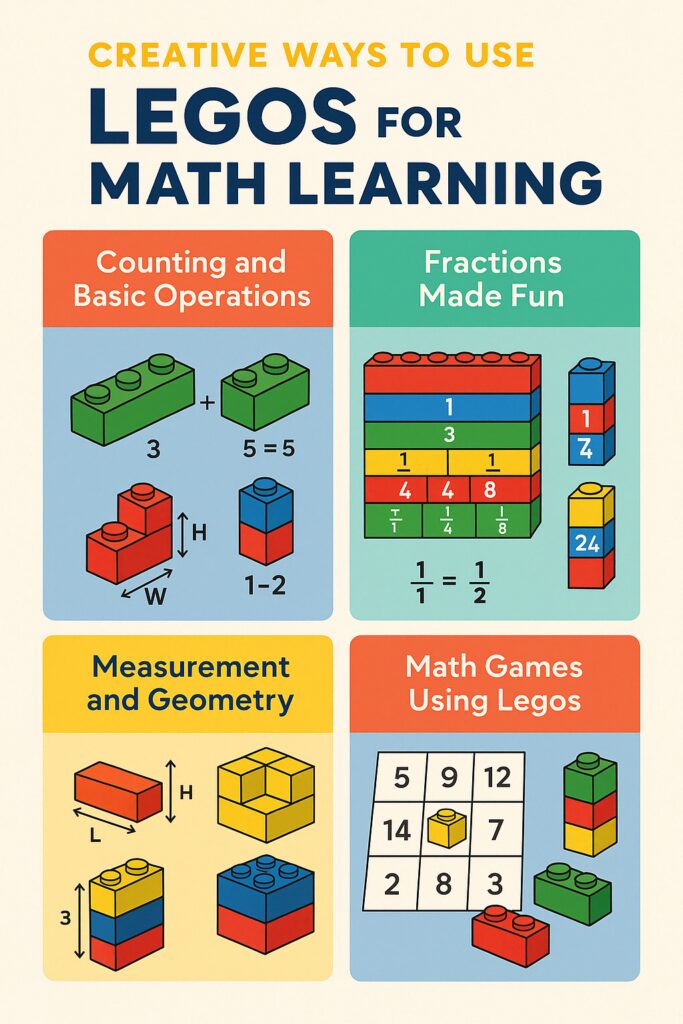When most people look at Legos, they see toys. But if you take a closer look, you’ll discover they’re actually tiny tools for teaching math. With their built-in structure, colors, and endless combinations, Legos make math hands-on, visual, and—best of all—fun. Let’s explore how you can turn a box of bricks into a powerful learning experience.
🧠 Why Legos Work for Teaching Math
Legos aren’t just about building towers—they naturally teach math concepts like counting, symmetry, sequencing, and logic. Kids learn by touching, moving, and experimenting, which makes the learning stick.

✔️ Built-in Math Structure
Every brick is built on a unit system. When kids compare sizes—like two 2-stud bricks matching one 4-stud brick—they’re actually seeing math in action.
✔️ Tactile, Hands-On Learning
Legos allow kids to feel math. They count studs, measure height, and literally build answers brick by brick.
✔️ Mistakes Don’t Hurt
When something doesn’t add up, it’s easy to take apart and try again. This encourages a growth mindset and removes the fear of getting it “wrong.”
➕ Teaching Basic Math Concepts with Legos
✅ Addition and Subtraction
- Addition: Snap a 3-stud brick to a 2-stud brick and count the total (5).
- Subtraction: Use two colored bricks—like a 5-stud red and a 2-stud blue. Remove one to see what’s left.
✅ Multiplication & Division
- Multiplication: Build 4 towers with 3 bricks each. That’s 4 × 3 = 12.
- Division: Take a 12-stud brick and split it into 3-stud groups. Count how many fit. Done!
🧩 Making Fractions Understandable
🍕 Fraction Walls
Build rows with bricks like 1-stud, 2-stud, and 4-stud to demonstrate halves, quarters, and eighths. It’s math that kids can see and touch.
🎨 Comparing Fractions
Stack 1/2 next to 2/4. Kids instantly recognize they’re the same size—no memorization required.
📏 Measurement and Geometry
📐 Measure with Bricks
Use bricks as non-standard units to measure pencils, books, or desk length. Kids learn about length, width, and height.
🧱 Building 2D and 3D Shapes
Construct squares, rectangles, cubes, and more. This boosts spatial awareness and shape recognition.
🔢 Area & Volume
Lay bricks flat to count surface area, or fill a box to demonstrate volume. It’s math you can build and see.
🎨 Sorting and Patterning
🟡 Sort by Color, Shape, or Size
Sorting helps with classification and early logic. Give a pile of bricks and ask your child to sort by color or the number of studs.
🔁 Create Patterns
Start a pattern like red-blue-red-blue and ask them to finish it—or create one with increasing stud numbers.
🎲 Math Games Using Legos
- Lego Bingo: Solve math problems and cover answers on a Bingo board using bricks.
- Scavenger Hunt: Hide bricks with problems written on them. Solve to collect.
- Race to Build: Shout a math problem and race to build the correct answer with bricks.
💵 Real-World Math with Legos
🛒 Mini Budgeting with Lego Money
Assign values to bricks and let kids “shop” with them. This builds budgeting and money sense.
🧍♂️ Story Problems with Minifigs
Create real-world math problems using Lego people: “Sara has 4 yellow bricks. She gives 1 to a friend…”
🔢 Understanding Place Value
🔟 Units, Tens, and Hundreds
Use different-sized bricks to show number places. One stud = unit, a 10-stud brick = ten, and so on.
🎨 Color Code Place Values
Use blue for units, green for tens, and yellow for hundreds. Color helps organize numbers visually.
🧮 Introducing Algebra the Easy Way
❓ Using Bricks as Variables
Use a red brick as “x.” Combine it with others to model problems like x + 2 = 5.
⚖️ Balancing Equations
Build a Lego balance to show that both sides of an equation should be equal—literally!
📊 Graphs and Data with Bricks
📈 Bar Graphs
Tally votes (like favorite animals) and build colored towers to represent results. The tallest tower wins!
🥧 Lego Pie Charts
Use circular bases and different brick segments to show percentages in a pie chart.
🕒 Teaching Time with Legos
🕰 Build a Clock
Design a clock face and use long and short bricks as hands. Great for teaching analog time.
⏳ Practice Elapsed Time
Start a task and use Lego bricks as minute markers. Helps visualize time passing.
🔧 DIY Lego Math Tools
- Number Lines: Snap bricks in a row and label each stud as a unit.
- Flash Cards: Stick math problems on one side and answers on the back. Flip to test yourself.
🏫 Tips for Parents and Teachers
🗓 Make Lego Math a Routine
Just 10 minutes a day can make a big difference. Use it as a warm-up or cool-down activity.
📚 Align with Curriculum
Match Lego tasks with current lessons. Studying shapes? Build them. Fractions? Stack them.
🧺 Keep It Organized
Use bins or bags to group math topics—like “place value” or “geometry”—for easy access.
🧠 Conclusion
Lego isn’t just for castles and cars. It’s a brilliant, kid-approved way to teach math—without it feeling like a lesson. Whether your child is learning addition or tackling early algebra, these bricks can bring math to life, one colorful click at a time.
❓FAQs
Can all ages use Legos for math learning?
Yes! Younger kids explore basic operations, while older kids can dive into fractions and algebra.
What if I don’t have many Legos?
Even a small set of 20–30 mixed bricks is enough to get started.
Do Lego math activities match school standards?
Most definitely. Especially for tactile and visual learners.
What skills can improve with Lego math?
Everything from counting, logic, and geometry to problem-solving and critical thinking.
Where can I find more Lego math ideas?
Check Pinterest, teacher blogs, and YouTube for free resources and printables.
